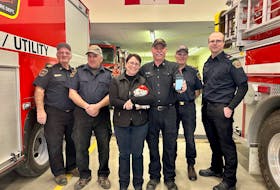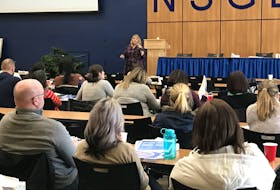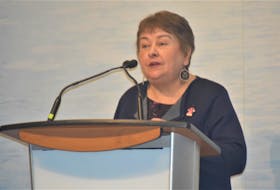
What she saw through her big brown eyes was normal to her. Having been born with impaired vision, she didn’t know there was any other way of seeing things.
Looking back on it, her mother, Robyn Coveyduck, said as her mom, she should have known.
“When we found out about it, I was so upset. I was devastated,” she said.
“I was blaming myself and thinking, how could we have missed this?”
Morgan was diagnosed in October by optometrist Dr. Sarah Hutchens. At that time her vision acuity was 20/100 in one eye and 20/200 in the other. She had astigmatism and two so-called “lazy” eyes.
Coveyduck said she was so distraught and had so many questions she turned to the CNIB for help. After speaking with support staff and Hutchens, she said certain behavioral indicators she’d noticed in her daughter over a few years started to make sense.
“I realized other things I saw in Morgan that I spoke to my family doctor about — we had her on a waiting list to be tested for ADHD — were all vision related,” she said. “Things like her concentration, not being able to focus on tasks, getting irritable, getting overwhelmed, all had to do with the issues of her poor vision. Not ADHD.”
When visited by The Telegram at home, Morgan, a petite girl of few words, is reading an American girl magazine. Looking through a small pair of purple glasses, she nods in the affirmative when asked if she likes wearing them, and nods again when asked if they have helped her in school.
During a recent gathering to launch May as Vision Health Month with the CNIB, Hutchens said early diagnosis is the key to ensuring a healthy future for children.
“If we don’t get to vision loss and treat it in time, they could permanently lose that ability to see,” said Hutchens, who is on the CNIB’s board of directors.
“The good news is that 75 per cent of vision loss is preventable or treatable, but if we don’t reach them between eight and 12, they may never have a chance at obtaining good vision,” she said.
Coveyduck said Morgan is on her third prescription in seven months and is doing well in school, but academically she is lagging a little behind her peers.
She said not being able to see properly and faking word recognition in kindergarten has left the family having to play catch-up.
“What we’re working on now is trying to get her caught up to where she should be. Kindergarten was a loss — well, not a loss, but she didn’t get out of it what the other kids did. Since her vision is improving, we’re now working on Grade 1 sight words and her reading has gone up two levels. Plus there is a remarkable difference in her artwork,” said Coveyduck.
She said following Morgan’s last checkup, glasses have addressed the astigmatism and her acuity is improving.
“I was thrilled her vision was at 20/50, which is your cutoff for getting your licence,” Coveyduck said excitedly.
“I’m still nervous. Her vision could get worse; we don’t know what could happen. But, as of right now, it’s 20/50, which means if she was at the age of driving she could drive, because if she can’t, that would be a big limitation,” she said.
Before Morgan’s poor vision was discovered, her mother said the only eye exam she ever had was a preschool screening by public health nurses.
She said it’s too bad it wasn’t caught before her daughter went to school.
“I’m not an eye doctor. I didn’t know it was something that should have been done. She passed her preschool check so we figured everything was OK. If public health or a doctor had suggested getting an eye exam, I would have done it,” said Coveyduck.
Debbie Ryan, who works in vision health promotion and communications for CNIB, said the family is not alone.
She said according to the organization’s statistics, only one in six children are tested before they start school.
“We’re also being told that if people can see, they think they don’t need to see an optometrist,” Ryan said.
“But even someone with 20/20 is at risk, and many eye diseases have no symptoms and can only be detected by a comprehensive eye exam,” she said, adding that around 3,000 people in this province have sought services from CNIB this year.
Coveyduck said she can’t stress the importance of seeing an optometrist. As a parent, she said, it is one of the most crucial things you can do for your children.
“One of the things I’m advocating for is public health to look at how they do their vision checks. Not that they should be equipped for full vison testing, because that is impossible, but all they do is generalized nearsighted tests using cards, a mirror and standing back about 20 feet, which is not adequate,” she said.
Coveyduck said she is also of the opinion if MCP covered the cost of the test, more people would have it.
Hutchens said there may be some substance to that assertion.
“It has come up that money can be an issue. But for doctors of optometry, it is better to spend the money to make sure your child’s eyes are OK then not spend it and think they are OK, because we never know how ... children are seeing,” she said.
“If we don’t spend the money or if government doesn’t cover it, which is what optometrists would like to see — government cover children up to the age of 10 — if they don’t, children have the potential to have permanent vision loss,” she said.
The doctor said this province is only one of two in Canada that doesn’t provide vision coverage for its residents. The other is Prince Edward Island.
In response to questions from The Telegram, the Department of Health sent an email.
“The Canada Health Act specifies the conditions and criteria which the provincial and territorial insurance programs must cover. These criteria require universal coverage of medically necessary services and those covered by a physician and oral surgical work in a hospital. Chiropractors, optometry, massage therapists and physiotherapy are examples of services not covered by the act,” says the email.
“Optometry services, which are not governed by the Canada Health Act, are not insured by the province. Prescription eyewear and eye examination are covered under most personal insurance plans. For residents that are on income support, assistance is available through the Department of Advanced Education and Skills.”
A spokeswoman confirmed the province did provide services prior to 1991.
Coveyduck said for minimum-wage earners who may not be eligible for support, it may mean having to choose between putting gas in their vehicle to get to work or a $70 eye exam.
“So that is why I’m talking to you as a parent, as part of Vison Health Month, because it is so important. The whole theme is get your eyes tested, and early vision care is necessary. It is not a luxury. It is a necessity,” she said.
(This is a corrected version)








